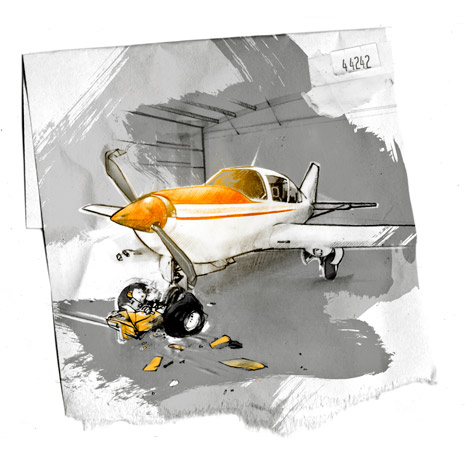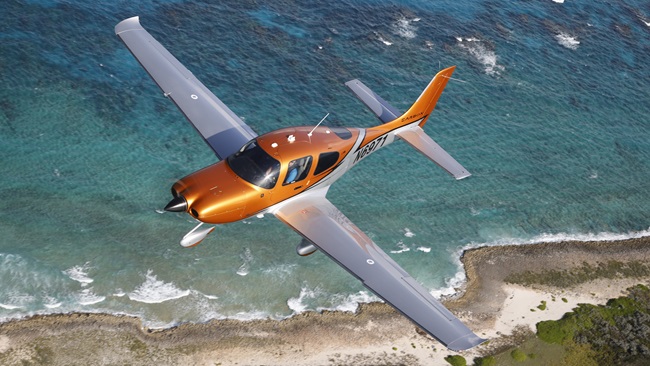 Aircraft are time machines in the truest sense of the word. My career involves significant travel, and without an airplane of my own to make those trips, I would spend a countless number of additional days on the road if I had to travel via the airlines. The biggest advantage it provides is more time at home with my family, on which a value cannot be placed.
Aircraft are time machines in the truest sense of the word. My career involves significant travel, and without an airplane of my own to make those trips, I would spend a countless number of additional days on the road if I had to travel via the airlines. The biggest advantage it provides is more time at home with my family, on which a value cannot be placed.
One day in the spring of 2010 presented a picture-perfect case for my time machine. My oldest daughter’s tenth birthday was the day before I had a big meeting in Kansas City. I needed to be home that night for her birthday dinner, but I also needed to be in Kansas City for a client meeting at 9 a.m. There were no airline options, so the decision was simple: I would fly myself to Kansas City after the kids went to bed that evening in order to be there for my meeting the following morning. The flight looked to be perfect with a southerly tailwind from Georgetown, Texas, forecast that night.
At the time, I owned a 1989 Bellanca Super Viking. I had a Garmin 430W with an excellent autopilot, so the trip up would be an easy three-hour flight. Just as planned, we enjoyed a fun evening and dinner with the family. Once the kids were off to bed I headed for the airport. It was about 8:30 p.m., and I figured I could be in Kansas City by midnight and in bed by 1 a.m.
I arrived at the airport to begin my normal routine of preparing for a flight. I follow this routine without any exception so that I will not forget anything important before each flight. I think of it as a flow checklist before I even enter the cockpit. I parked by the T-hangar to the south of my door, and opened up the hangar. While the winch was raising the bi-fold door, I loaded the airplane. Next, I checked the lights for night operation, completed the preflight, and confirmed the fuel level. I connected the tug to the nosewheel and pulled the airplane out of the hangar, turning it to the north.
I realized I had forgotten to grab a flashlight from the cabin. I would need the light walking out of the hangar after I closed it up in a few minutes. I disconnected the tug, pulled it back three feet, and walked around the wing to retrieve the flashlight. Next, I parked my truck in the hangar and closed it up. I exited the door, turned off the lights, and boarded the airplane approaching from the tail.
Inside the cabin, I took my time to get everything situated around me with the flashlight. Master on, I started the engine and flipped on the avionics master. I listened to ATIS and called ground for my clearance. Finally, I was cleared to taxi to Runway 18.
If you were paying attention—which I was not—I discovered my critical error roughly three feet into the taxi. The propeller struck the tug three very violent times before moving it left enough for me to see it in the taxi light. The engine didn’t completely stop, so I had to manually shut it down as quickly as possible. I knew immediately when the first blade hit what had happened, but it was too late. The tower and I stepped on each other while trying to communicate immediately afterward. I called him back on the radio and said he could cancel my clearance. He asked if I was OK, to which I responded that I was fine. I shut everything down and exited the airplane with that same flashlight that had broken my flow.
There were parts from the tug lying on the ground next to the hangar, along with significant scarring on the hangar siding where those parts had struck. The force with which they hit was obvious. The prop was destroyed, and there was a slight crease in the front nosewheel door. Otherwise, the airplane was unscathed. How the left wing avoided any damage, I have no idea. I would later discover that some of the tug parts were on top of the hangar and even on the ground on the opposite side of the building.
The tower called the medevac office located right beside my hangar. One of the guys came over to see what happened. He helped me put the airplane back in the hangar, doing his best to make me feel a little better given the circumstance. It was a gracious gesture from a fellow pilot who understood what I was feeling at the moment. We buttoned everything up, and I sat down in my truck to decide what to do next.
I had never been in any type of accident in which damage was done. I was in complete shock. I was mad at myself. I was embarrassed. I was scared to death of what it was going to cost to fix. And, as you may recall, I had a meeting at 9 a.m. in Kansas City. I called an airline to book a 6 a.m. flight from Dallas to Kansas City. It was now almost 10 p.m. I had a three-hour drive to Dallas ahead of me, so I hit the road. I made the meeting with exactly zero sleep. Somehow, it went great.
Two major lessons came from that night. First, never break the flow you are accustomed to when preparing for a flight. Second, a new item has been added to that preflight flow—walk around the front of the airplane prior to boarding.
Ty Flippin is an instrument-rated private pilot with 23 years of flight experience. He and his family live at an airpark and own an American Legend Cub.
Digital Extra: Hear this and other original “Never Again” stories as podcasts every month and download audio files free from our growing library.
On the Web: www.aopa.org/never_again


